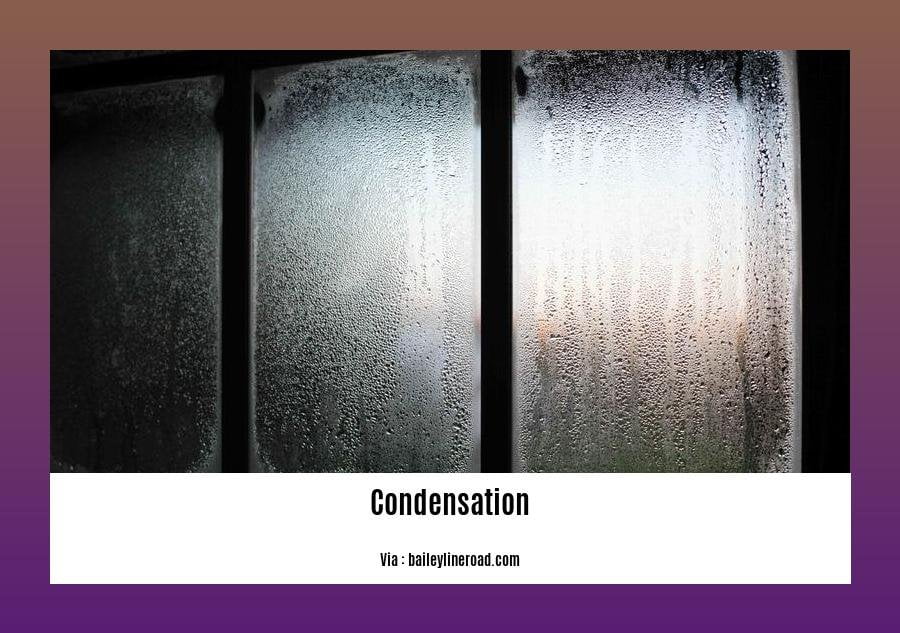Discover the intriguing world of condensation with our article, “Fascinating Facts About Condensation: Uncovering the Mysteries of this Natural Phenomenon.” Dive into the wonders of the water cycle and explore the captivating science behind condensation. From its ubiquitous presence in our daily lives to its vital role in shaping weather patterns, condensation truly is everywhere. Join us as we unveil the secrets behind this remarkable process and shed light on its importance in understanding the world around us.
Key Takeaways:
- Condensation is the process where water vapor turns into liquid, which is the opposite of evaporation.
- Condensation occurs when the air becomes saturated with water vapor or when it is cooled to its dew point.
- The dew point is the temperature at which condensation happens.
- Clouds are formed due to condensation.
- All phase changes leading to condensation can be reversed.
- Molecules in a gas cool down, lose heat, and slow down to form a liquid during condensation.
- Condensation plays a crucial role in the water cycle.
- For more information, visit:
- National Geographic Society
- Kids Kiddle
Facts About Condensation


Condensation, a fascinating natural phenomenon, plays a crucial role in our daily lives. Let’s uncover some intriguing facts about condensation and explore the mysteries behind this process.
The Reverse of Evaporation
Condensation is the opposite of evaporation. While evaporation involves the transformation of liquid into vapor, condensation is the process where water vapor becomes liquid again. It occurs when molecules in a gas cool down, lose heat, and slow down, eventually forming a liquid.
The Dew Point and Saturated Air
Condensation occurs when either the air cools down to its dew point or becomes saturated with water vapor. The dew point is the temperature at which condensation takes place. When the air reaches this point, it can no longer hold all the water vapor, leading to the formation of liquid droplets.
Cloud Formation
Have you ever looked up and marveled at the beautiful clouds above? Well, condensation is responsible for their creation! As warm air rises, it expands and cools, causing the water vapor within it to condense into tiny water droplets or ice crystals. These clusters of condensed water vapor form clouds, which come in various shapes and sizes, adding charm to our skies.
Reversibility of Phase Changes
All phase changes leading to condensation can be reversed. This means that when the environmental conditions change, the liquid water formed from condensation can evaporate back into the atmosphere, completing the cycle. It’s a constant dance between evaporation and condensation, maintaining the delicate balance of Earth’s water cycle.
Key Component of the Water Cycle
Condensation is an essential part of the water cycle, which is responsible for redistributing water across our planet. As water evaporates from oceans, lakes, and rivers, it rises into the atmosphere as water vapor. When it cools or encounters saturated air, condensation occurs, forming clouds and ultimately leading to precipitation. This precipitation replenishes our freshwater sources, nourishing ecosystems and sustaining life.
By understanding these facts about condensation, we gain a deeper appreciation for the scientific processes shaping our world. From the formation of clouds to its pivotal role in the water cycle, condensation is a captivating phenomenon that continuously unfolds around us.
Remember, the wonders of nature are often found in the simplest of processes, like the transformation of water vapor into liquid through the magic of condensation. So, next time you observe dewdrops on a morning leaf or gaze at the majestic clouds above, take a moment to marvel at the intricate beauty of this natural phenomenon.
Sources:
In the fascinating journey of the water cycle, have you ever wondered about the mesmerizing process of condensation? Find out intriguing facts about condensation in the water cycle here and uncover the hidden mysteries of this natural phenomenon.
Discover the awe-inspiring wonders of the desert southwest region by exploring intriguing facts about the diverse landscapes, unique wildlife, and rich cultural heritage. Take a deep dive into the wonders of the desert southwest region here and let yourself be captivated by its enchanting beauty.
Condensation is Everywhere!
Condensation is a fascinating natural phenomenon that can be found all around us. From the formation of clouds in the sky to the dew that collects on grass in the morning, condensation plays a significant role in various aspects of our daily lives. Let’s uncover some intriguing facts about condensation and gain a deeper understanding of this ubiquitous process.
The Water Cycle and Weather Patterns
Condensation is a crucial part of the water cycle, which is the continuous movement of water on Earth. As warm air rises and cools, water vapor in the air cools down and changes into liquid, forming tiny water droplets. These droplets come together to create clouds, which can lead to precipitation such as rain, snow, or hail. So, the next time you see fluffy clouds in the sky, remember that condensation played a vital role in their formation.
Saturation and Dew Point
Condensation occurs when the air becomes saturated, meaning it can no longer hold any more water vapor at the existing temperature and pressure. The temperature at which air needs to be cooled for condensation to happen is called the dew point. When the dew point is reached, the excess water vapor in the air condenses into liquid droplets, leading to the visible formation of moisture.
Everyday Examples of Condensation
Have you ever noticed water droplets on the outside of a cold drink glass on a warm day? That’s condensation in action! When warm, moist air comes into contact with a cooler surface, such as the glass, the air cools down. As a result, the water vapor in the air loses heat and slows down, eventually forming water droplets on the surface of the glass. This same phenomenon occurs when you see fog on the bathroom mirror after a hot shower.
Key Takeaways:
- Condensation plays a vital role in the water cycle and the formation of weather patterns.
- It occurs when the air becomes saturated and can no longer hold any more water vapor at the existing temperature and pressure.
- The dew point is the temperature at which air needs to be cooled for condensation to happen.
- The visible examples of condensation include water droplets on cold surfaces and fog on mirrors.
- Understanding condensation helps us comprehend its occurrence in everyday life and appreciate its significance in various natural phenomena.
For more information about condensation and other intriguing scientific facts, you can visit the following sources:
Condensation is truly everywhere, shaping our weather patterns and leaving its mark in our daily experiences. By unraveling the mysteries of this natural phenomenon, we can deepen our appreciation for the intricate workings of the world around us. So, let’s continue to explore and marvel at the wonders of condensation.
FAQ
Q1: What is condensation?
A1: Condensation is the process where water vapor becomes liquid and is the reverse of evaporation. It occurs when either the air is cooled to its dew point or becomes saturated with water vapor.
Q2: What is the role of condensation in the water cycle?
A2: Condensation is a key stage in the water cycle, where water vapor in the air cools down and changes into liquid. It plays a vital role in the formation of weather patterns, as warm air rises and cools, causing water vapor to condense and form clouds.
Q3: How does condensation occur?
A3: Condensation happens when molecules in a gas cool down, lose heat, and slow down, eventually forming a liquid. It can be observed when warm, moist air comes into contact with a cooler surface, causing the air to cool down and water droplets to form.
Q4: What is the dew point and its significance in condensation?
A4: The dew point is critical for condensation to occur, as it refers to the temperature at which air needs to be cooled for condensation to happen. When the air becomes saturated and can no longer hold any more water vapor at the existing temperature and pressure, condensation takes place.
Q5: How does condensation manifest in everyday life?
A5: Condensation can be observed in various everyday occurrences. For example, when you see water droplets forming on cold surfaces like windows or mirrors, it is a visible example of condensation. Understanding the factors that contribute to condensation, such as moisture saturation and the dew point, helps in comprehending its occurrence in everyday life.









